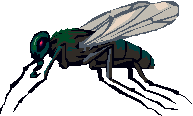
Equus grevyi
Alexandra E. Price
History
Grevy's zebras were first shown to
Europeans in the colosseum in Rome by
the Emperor Caracalla (Marcus Aurelius
Antoninus, 211-217 AD). In the
17th century, they
were rediscovered when Kind Assaghedus
of Shoa, in Ethiopia, sent three animals
to the Ottoman Sultan. Menelik II,
King of Shoa and Emperor of Abyssinia,
sent a live animal to Jules Grévy,
President of France, in 1882.
Although it died upon arrival, it was
still stuffed and exhibited in the
Museum National d'Histoire Naturelle,
Paris. Honoring the President, the
type of zebra was named Grevy's.
Behind the stripes...
There are several
theories that explain the purpose of the
unique stripes that zebras exhibit.
Black and white striped patterns have
been retained and selected for
throughout evolution of the zebra, and
we are not quite certain as to why.
The four main speculations over the
significance of the stripe are to avoid
predators, certain social benefits,
thermoregulation, and protection from
pesky insects.
1.
Predation avoidance:
Stripes are an optical illusion that
make a zebra appear larger and dazzle
the predators. Stripes disrupt a
zebra's outline and make it hard for the
predator to single out an individual
zebra from the rest of the herd.
Stripes also blend in well with tall
grasses and provide camouflage.
Behind a screen of small branches a
zebra's fine stripes blur its frame.
In poor light, stripes are hard to
distinguish. During the daylight,
zebra stripes are easily visible in an
open grazing ground. When viewed
at a distance under poorer lighting
conditions, zebras are much harder to
notice. This may be a benefit
because lions and hyenas commonly hunt
at dusk and dawn.
easily visible in an
open grazing ground. When viewed
at a distance under poorer lighting
conditions, zebras are much harder to
notice. This may be a benefit
because lions and hyenas commonly hunt
at dusk and dawn.
2. Social benefits: Stripes might promote group bonding and zebras with unusual patterns are thought to be more likely social outcastes. Additionally, stripes might be markers for grooming or individual identifying devices. There are differences between individuals striping patterns and these stripes might be used to tell each other apart.
3. Thermoregulation: Stripes might be a mechanism for the zebra to stay cool. Some people believe that rotary breezes could be created by differential cooling of the black and white zones.
4. Protection from tsetse flies: Zebras do not seem to be a favored host for tsetse flies. Researchers have done several tests with tsetse flies and found that they are attracted less to striped models compared to solid colored models.

These theories are
still very controversial, but all have
fairly valid reasoning behind them.
Which do you think is the true
reasoning behind the stripe?
Copyright © 2007, Design by: Sunlight webdesign